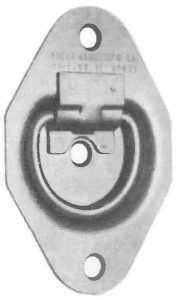
For a quick and effective tie-down solution, look no further than a rope ring. They are commonly used to secure loads. You can mount a rope ring on a safe, supportive structure. Once mounted, you can connect a rope or chain to it. To learn more about rope rings and the benefits they offer, keep reading.
What Are Rope Rings?
Rope rings are mountable rings that are designed to create an anchor point. As shown in the adjacent photo, they typically consist of a frame with a D-ring. The D-ring is the part of the rope ring to which you can connect a rope or chain. It’s known as a “D-ring” because it’s shaped like the letter D.
Recessed vs Non-Recessed Rope Rings
Some rope rings are recessed, whereas others are not recessed. They are both designed to create an anchor point, and they both support ropes and rings. The difference lies in the way in which they are mounted.
Recessed rope rings are mounted so that they remain flush with the surface. Non-recessed rope rings, on the other hand, are mounted so that they protrude out of the surface. Of those two types, recessed rope rings are typically more common.
Rope Ring Material
You might be wondering what material rope rings are made of. Because they are designed to create an anchor point for ropes and chains, rope rings are typically made of metal. Some of them are made of stainless steel with at least 11% chromium. Other rope rings are made of zinc-plated steel.
Both stainless steel and zinc-plated steel rope rings offer a high level of protection against corrosion. Even when used in wet or humid environments, they won’t rust easily. They are strong, durable and weather-resistant materials that can withstand moisture.
How to Mount Rope Rings
You can easily mount rope rings using a set of threaded fasteners. Before mounting a rope ring, though, you should identify an appropriate surface. Most rope rings can be mounted to the wall or ground, and many of them can even be mounted to vehicles as well.
After identifying an appropriate surface, you can drive the threaded fasteners through the rope ring’s hopes and into the underlying material. Most rope rings have three holes: one at the top, bottom and in the middle. Driving a threaded fastener through each of these holes will secure it to the surface.
